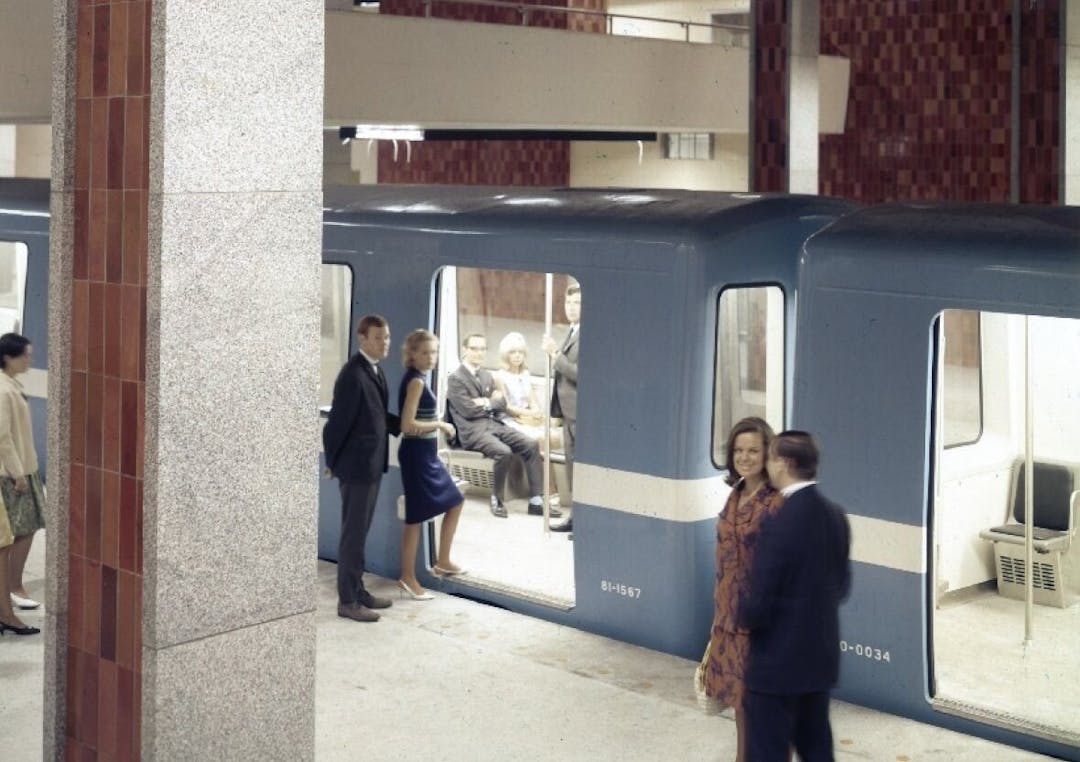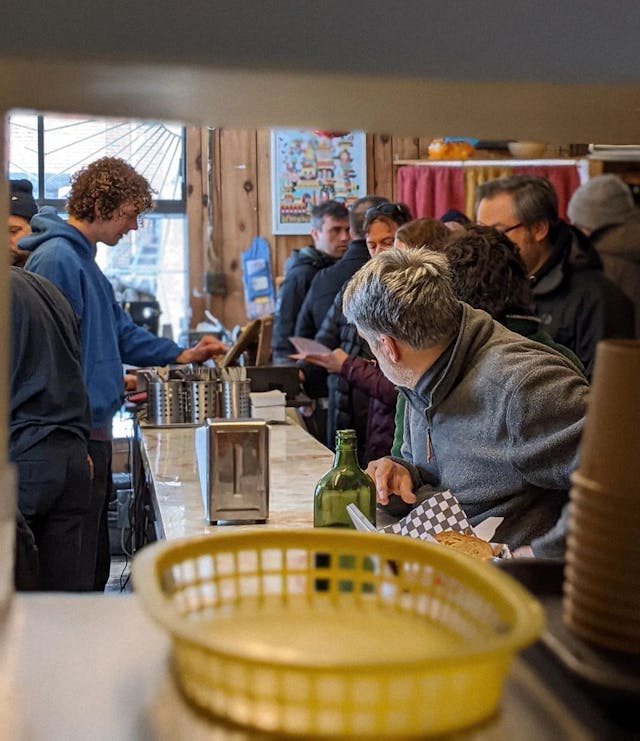The Montreal Metro's inauguration, 57 years later
A look back at the inauguration of Montreal’s metro, a unique system with a unique story, made by and for Montrealers.
 Montrealers at Rosemont station in 1966. | Photograph: Archives de Montréal
Montrealers at Rosemont station in 1966. | Photograph: Archives de MontréalWith fuss and fanfare, dignitaries and pretty girls, noise and confusion, Montreal’s magnificent metro was officially christened by some 5,000 enthusiastic citizens yesterday afternoon. … Trains filled with hundreds of special guests pulled out of the 19 stations along north-south and east-west lines to converge on the Berri-de Montigny station where the two lines meet. Within minutes, the first rubber-tired train rolled smoothly in and the first official subway travelers were greeted by a broadly smiling Mayor Drapeau. (The Gazette, Saturday, October 15, 1966)
Last weekend, on October 14th, the 57th anniversary of the Montreal metro’s 1966 inauguration came and went like a pizza-munching rat at Berri-UQAM.
Truth is, we love the metro. Always have. Sure, it has its problems—that colour palette of hamburger meal at Guy-Concordia, those bonkers and jury-rigged quick fixes you find at Laurier to stop the leaks coming in from above, the wooden sculpture at Lionel-Groulx that freaked us out on a bad mush trip that one time—but it remains a (reasonably) safe, reliable, and inexpensive way to get all over town.
While the system’s got its fair share of perks and blemishes now, we’ve come a long way from those first few pristine days.


Employees visit at stations in 1966 | Photograph: STM
Let’s take a metro ride down memory lane
When the metro opened, we were the 26th city in the world to open a metro system—but ours was the first in the world to be silent thanks to being an entirely rubber-wheeled subway (though that was a choice made to save money and allow it to accelerate and stop quickly).
Based on Parisian rubber-tire (pneumatic) metro trains at the time which could reach speeds of just over 40km/h in less than seconds—faster than trains in eight other global cities—and despite how expensive and time and resource-intensive they could be, that wasn't the only way the City of Light served as a big source of inspiration: An Art Nouveau-style archway of cast iron and Comblanchien stone designed by artist Hector Guimard and dating back to the Paris metro's beginnings in 1900 would be installed at Square Victoria-OACI station in 1967.
"I took the (metro in) Paris, but this one is much more beautiful," a passenger told journalists Raymond Lebrun and Claude Jean Devirieux in an October 14, 1966 broadcast.
Montreal Goes Underground (1966) | Source: YouTube
People were ecstatic. A new, 26km-long network of four lines (finished by the spring of 1967) finally coming to life $213 million ($1.9 billion today) and 5,000 workers digging and installing later.
“As hard as it might be to believe today, in a city notorious for corruption and construction delays, it was built economically and remarkably quickly,” wrote Jason Magder and Marian Scott.

Blessed by an Archbishop and the press of a button
It was new, shiny, perfect; Cardinal Paul-Émile Léger, then the Archbishop of Montreal, blessed the brand system before passengers boarded it for the very first time—maybe that’s why it’s still working.
The mayor Jean Drapeau was told to press a button to send the three-car train he was on forward 15 feet. Huzzah: It would a moment that cemented what would be his greatest achievement of his 30-year reign.
One million people tried it during the first weekend of operation. More than 130 million trips were recorded in the first year, marked by the holding of Expo 67 which attracted more than 50 million visitors. For comparison’s sake, 245,514,900 trips were completed in 2022.


Metro control centre in 1966 (left) and a train in the tunnel in 1966 | Photograph: STM
The crash and cooking peanuts
It was warm inside—too warm for the first year, and reportedly caused one métro operator to faint in their cab which caused the train to crash into a wall at what is now Berri-UQAM station. That amount of heat led to our ventilation shafts today that push wind like crazy via what the STM calls the “piston effect.”
The air also smelled of peanut oil, as wooden brake shoes dipped in peanut oil were used to stop the tires of the early MR-63 cars from turning. That’s no so much the case any more with the new AZUR cars made by Bombardier (who also built the MR-63s under the name Canadian Vickers) even though they still use wooden brakes. We’re gonna miss that smell.
MR-63s were officially retired from service in June 2018 after 52 years of loyal service. However, some are being recycled in interesting ways, like using cars to shape a new building in Griffintown that will open in 2025. Named after their code, it'll be a massive venue for art, gastronomy and design with event spaces.
"Like a living organism, it will contribute to the reduction of CO² emissions, with an ecologically regenerative approach," writes the MR-63 project founders Etienne et Frédéric Morin-Bordeleau.


Artist Jean-Paul Mousseau's ceramic tiles of Peel station (left) and a kiosk at Saint-Laurent station in 1969. | Photograph: Archives de Montréal & STM
The local condition
The train took Montrealers from station to station, each unique thanks to the design of modernistic, above-ground édicules or entrances as the city didn’t have the wide sidewalks to support in-ground entrances found in cities like New York or London—and we have way too much snow and ice in the winter.
Nearly every station’s design would come from a different architectural firm, making each one unique, arguably more cost-effective, and part of the reason why the city’s so lauded for its diversity of design today. Corporate donors sponsored signature artworks in many stations back then as well, like artist Nicolas Sollogoub’s painted glass murals in McGill station which illustrate the history of Montreal from 1800 to 1870.
According to the Montreal Gazette, "the Steinberg’s supermarket chain underwrote the stained-glass mural in Place-des-Arts station by Frédéric Back, illustrating the history of music in the city."
Other art pieces would form part of the architecture of the stations as well, like the multi-coloured circles of hand-painted glass tiles from artist Jean-Paul Mousseau at Peel Station and the abstract stained-glass windows of Marcelle Ferron at Champ-de-Mars.
Not all stations got sponsors, however, so some stations looking pretty empty by comparison, and some ideas were never realized: The Longueuil and Île-Ste-Hélène (now Jean-Drapeau) stations, for example, never received four sculptural fountains that should have been installed at their entrances because no one could sponsor them.
Failures like these led to a new art policy beginning in 1970.


Photograph: Jamshed Khedri & Steven Wright
57 years and 71 km later
It doesn't just get us from point A to B, or give us a place to catch up on podcasts.
Montreal's metro system has taken on whole new dimensions of meaning for locals: The stations are art pieces. The cars are mobile parties during festivals, humming with energy inside and out.
Its history echoes back as we make new memories within it, and outside of it with new and regerative projects.

